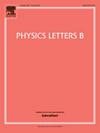FastEEC: Fast evaluation of N-point energy correlators
IF 4.3
2区 物理与天体物理
Q1 ASTRONOMY & ASTROPHYSICS
引用次数: 0
Abstract
Energy correlators characterize the asymptotic energy flow in scattering events produced at colliders, from which the microscopic physics of the scattering can be deduced. This view of collisions is akin to analyzes of the Cosmic Microwave Background, and a range of promising phenomenological applications of energy correlators have been identified, including the study of hadronization, the deadcone effect, measuring and the top quark mass. While N-point energy correlators are interesting to study for larger values of N, their evaluation is computationally intensive, scaling like , where M is the number of particles. In this Letter, we develop a fast, approximate method for their evaluation exploiting that correlations at a given angular scale are insensitive to effects at other (widely-separated) scales. This implies that the energy correlator can be computed on (sub)jets, effectively reducing M. Furthermore, we utilize a dynamical (sub)jet radius that allows us to obtain reliable results without restricting the angular scales being probed. For concreteness, we focus on the projected energy correlator which projects onto the largest separation between the N directions. E.g. for we find a speed up of up to four orders of magnitude, depending on the desired accuracy. We also consider the possibility of raising the energy to a power higher than one in the energy correlator, which has been proposed to reduce soft sensitivity. These higher-power correlators are not collinear safe, but as a byproduct our approach suggests a natural method to regularize them, such that they can be described using perturbation theory. This Letter is accompanied by a public code that implements our method.
求助全文
约1分钟内获得全文
求助全文
来源期刊

Physics Letters B
物理-物理:综合
CiteScore
9.10
自引率
6.80%
发文量
647
审稿时长
3 months
期刊介绍:
Physics Letters B ensures the rapid publication of important new results in particle physics, nuclear physics and cosmology. Specialized editors are responsible for contributions in experimental nuclear physics, theoretical nuclear physics, experimental high-energy physics, theoretical high-energy physics, and astrophysics.
 求助内容:
求助内容: 应助结果提醒方式:
应助结果提醒方式:


